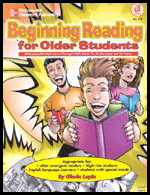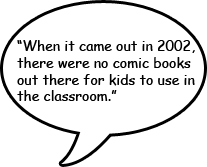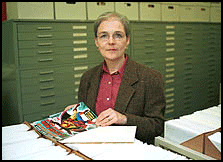
 |
|
|
Gloria Lapin saw the educational potential of comics while teaching in the Atlanta area. Her teaching career spanned more than three decades and included three Teacher-of-the-Year awards, but the 57-year-old said it was not until the early 90s when one of her first graders was having trouble reading that she decided to try something different. “The boy did fine in math, but reading was non-existent. None of the reading materials that I had worked,” said Lapin. “He had a lot of difficulty…and I sensed that it was because of his frustration with his inability to learn to read.” Because there were no materials for him, Lapin said she would go home and write little books for him herself. She said her creations worked and at the end of the year they were published in a collected format as Sight Word Stories. |
|||||||||||||||||||||
|
||||||||||||||||||||||
| Gloria Lapin,best-selling educational book author, who was inspired by comic books. | ||||||||||||||||||||||
 Lapin's Sight Word Stories |
||||||||||||||||||||||
“I got responses from teachers of English language learners and teachers of older children who had difficulty learning to read saying ‘could you please re-write these, so they’re not little teddy bears and ducks and dogs? And put the same type of work with vocabulary in a more sophisticated venue?’ That’s when I wrote a book call Beginning Reading for Older Students,” said Lapin. “When it came out in 2002, there were no comic books out there for kids to use in the classroom.” |
||||||||||||||||||||||
 |
||||||||||||||||||||||
The first half of the book focuses on developing vocabulary. The second half makes use of that vocabulary and is written in the comic book format of sequential panels. “The whole idea of reading is that we get meaning from those little symbols that are on the page. Anything we can use to help us get meaning from those symbols helps us to get where we need to go. If we’ve got children who have difficulty translating those symbols into meaning and we give them the support or the scaffolding of some pictures to go along with it, we’re helping them to get to where they need to go,” explained Lapin.
|
||||||||||||||||||||||
| Lapin's Beginning Reading for Older Students |
||||||||||||||||||||||
Teachers from across the United States, including teachers for the learning disabled and English as a second language, found Lapin’s first books very effective and responded with such praise that Lapin said she was inspired to write more. Lapin currently has four more books due out the summer of 2005. She said they are intended for “kids with learning disabilities and beginning readers at all levels.” |
||||||||||||||||||||||
“If you’re a 12-year-old boy and you have to read at a first grade level and you walk around carrying what at first glance looks like a comic, none of your classmates would ever guess that you were reading something on a first grade level,” said Lapin. According to her, it often does not even occur to her target audience that they are reading on a first grade level. A factor that Lapin said may someday make this applicable to adult literacy as well. |
||||||||||||||||||||||
 |
||||||||||||||||||||||
|
||||||||||||||||||||||
| Young readers in the public library in Freeport, Ill., AP Photo Archive | ||||||||||||||||||||||
 |
“Comic books are fun. The pictures attract students to them,” she added. Lucy Caswell, the curator of the Cartoon Research Library at The Ohio State University, said she believes most comic books are not currently suited for educational purposes, because they’re not comparable to literature. “The reading level of comic books and the quality of the writing has been less than one might desire,” said Caswell. “On the other hand, I would say reading something is better than nothing.” |
|||||||||||||||||||||
| Lucy Caswell, Professor, School of Journalism and Communication Curator, Cartoon Research Library, The Ohio State University | ||||||||||||||||||||||
|
Lapin said she is not trying to teach children to read comics, but she views comics as a very important step for readers. “I see comics as the opportunity for the transition from the very early decodable books into more complicated literature,” said Lapin. “Comic books are a tool that teachers need to take a look at.” |
||||||||||||||||||||||